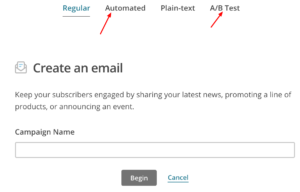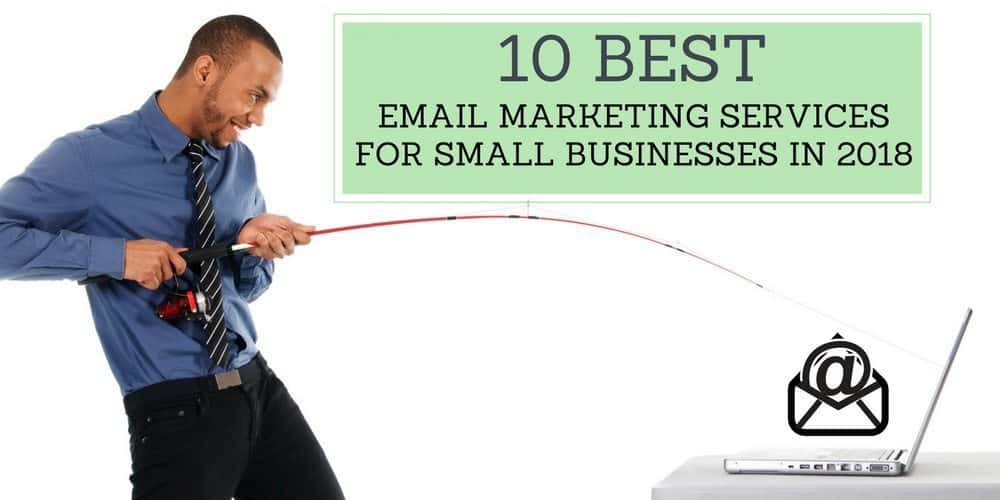11 Best Email Marketing Software Options for Small Businesses
Email marketing is the primary means of communications for big brands and small companies alike targeting today’s consumer
Over the years, email service providers, such as Gmail, have created logical and appealing inbox displays that make both personal and brand communications function seamlessly together.
That is right, emails from mom and emails from IKEA can all exist harmoniously. This means that businesses can and should use email as their primary form of messaging with its customer base.
If your company is not focused on email, as a business owner, you are falling behind.
However, choosing the right internet marketing software solution can be a confusing process. I deal with this on a daily basis with my SEO Consulting clients.
My 11 Best Email Marketing Software Options for Small Businesses list is here to help simplify this process for you.
First, let’s have a look at a few core competencies we will be looking at when reviewing email software platforms.
Ease Of Email Automation & Trigger Emails | How Confusing Is It?
One of the major critical components of email is automation tools.
Automation can allow a business to automatically send a subscriber an email based on their activity, their subscribe date or even their birthday.
Sometimes called “trigger emails,” email automation software capability and flexibility is one primary divider between a decent service and a great one.
But what if that automation is super confusing? Or what if it is so simple that it is restrained and inflexible?
Email Newsletter Creation | You Shouldn’t Have To Be Monet
These days, most email newsletters are opened using a mobile device.
If your newsletter template contains too much bloat, it might be difficult to read on an iPhone, which would be a killer to your offer. Having the ability to quickly create unique and professional templates is imperative to running successful email marketing campaigns.
Email marketing platforms, Will Your Messages Go To Spam?
Most of the services listed below do an excellent job of getting your emails in your subscriber’s inboxes.
They do this by setting universal standards for all their clients, which will include your business.
Some services are looser than others, which might be reflective of the size of their brand (the more Google knows and trust the service, they are going to inbox more messages).
When you choose to go with free marketing software to save money, you risk your messages never seeing the light of day.
Email software marketing services can make or break a small business.
Choosing the right service is essential for creating more revenue and growing a brand. Email marketing strategy works. It has one of the highest ROIs of any online marketing tactic.
Let’s have a look at some of the best email campaign software around.
MailChimp
Our first service is the most recognizable brand of them all, MailChimp. But is it the best?
MailChimp is popular because they offer both free and paid versions of their service and the Atlanta-based company has been around for 17 years. Online marketers know the MailChimp name.
MailChimp offers a useful web-based option if you are just starting to build your list and want to eliminate initial investment.
People with huge mailing lists might want a service with more perks. However, don’t sell Mailchimp short, this is a professional service that’s an email service provider for many large businesses.
The free service has a lot to offer.
If you use the free version of MailChimp, you can:
- Grow your list up to 2,000 subscribers
- Send up to 12,000 emails per month
- Get access to all of Mail Chimp’s standard features
Upgrading to one of their paid plans will buy you additional features. These include:
- Advanced sign-up forms with sending and tracking ability
- Imports contacts from existing subscribers lists
- Inbox preview so you can see how your emails look
- Time Warp so emails arrive at the same time in different time zones
- Social networking profile implementation
- Marketing automation integration for your Zoho campaigns and other CRM systems
They offer both a monthly plan and a pay-as-you-go plan. The latter is ideal if you send email rarely. It works on a system of non-expiring email credits. Once you have bought them, you can use them as you see fit.
One of the most significant benefits of using MailChimp is that you are almost guaranteed to get into your subscriber’s inboxes. MailChimp is a trusted brand; all major email providers know who they are.
This should be a significant consideration considering that most subscribers use only one of four different ISPs in Gmail, Yahoo!, Hotmail/Outlook, and AOL. Gmail is the leader of the pack. If you are not getting inboxed by Gmail, your offers are as good as dead.
That said, MailChimp is notoriously strict with affiliate offers. Being strict with content sent out via MailChimp’s services is one way that MailChimp remains a trusted and powerful email marketing service among the major providers. If you are an affiliate marketer, you might look elsewhere.
MailChimp recently upgraded the way their automation and A/B testing functions. This upgrade made them easier to use. In the past, businesses often complained about how complex the process to create automated, or trigger emails, seemed.
Now, when you click “create a campaign,” simply choose between sending a regular real-time email campaign, setting up an automated campaign, or creating an A/B test.
Here’s a screencap of MailChimp’s simplicity following their upgrade.

MailChimp makes A/B testing, creating automated emails, and sending regular emails a simple, fluid process.
Once you choose automation, the condensed option list makes it pretty simple to create automated email campaigns.
They already have a trigger for birthdays set up which you can activate. If you want the trigger email to be based on subscriber activity, you choose that option. Most automated emails can fall under editing and replicate the “welcome email.”
Here’s a look:
Creating a newsletter in MailChimp is simple.
MailChimp offers some sharp templates that are also mobile responsive. Their editor is simple to use. However, I have noticed issues when copying over text into their editor. At times, I find I cannot make formatting changes.
I have learned that sometimes it is best to just start over.
One important note regarding MailChimp: recently, they made headlines by changing its default subscriber signup settings to single-opt-in (except in Europe).
Prior, they used the more conservative double-opt-in as their main default setting.
Why is this big news? MailChimp is the global leader in email service providers. They set the standard. Changing to single-opt-in sent a clear message to all online marketers that single-opt-in is no longer the devil. If you want to have your setting as double-opt-in, you will need to set that yourself.
MailChimp has also slyly created more robust stats that are only available in their Pro Marketer plan.
I make a special note of this because at some point, you will want more information on your subscribers and you will be told you need to upgrade for that.
MailChimp is great for online marketing newbies but becomes pricey for more complex business setups.
Your subscribers are more likely to get your messages and offers when you use MailChimp, their newsletter design editor is simple and easy, and their automation services are straightforward. MailChimp is extremely dependable.
They are also priced fairly for initial list building.
CON: One of the significant downsides is that their client support is lacking, especially the live chat.
You cannot call them; you must use their chat system which is often unavailable or experiencing long waits.
Most every question you ask will be given a response with a link to a help guide. That help guide link may or may not be relevant to the issue you have inquired about. If you are someone who needs a little coddling, MailChimp might not be for you.
MailChimpPricing Plans:
Paid plans range from $20 per month up to $199 per month for the Pro Marketer add-on.
Constant Contact
Constant Contact is one of the top email service providers in the game.
They offer competitive pricing and some nice features to help you manage your email campaigns.
Constant Contact is considered a more robust email service experience to services like MailChimp and AWeber, but that also means a bit more complicated interface and a higher price point.
Here are some quick features:
- Hundreds of customizable, responsive templates for mobile devices
- Drag-and-drop editing of your emails
- Social media marketing and management tools
- Email scheduling platform accessible on the mobile app
- User satisfaction survey, coupon, and other functionalities
- Free live support
Constant Contact has more features and functionality than MailChimp. It is also a bit more expensive than MailChimp. You will need to choose one of their Email Plus plans to get full automation.
Constant Contact is a big bloated, archaic email service provider system.
Make no mistake about it, using Constant Contact is much more laborious than using MailChimp or AWeber is. Constant Contact is one of the first big email service providers; they are a staple in the online marketing industry. However, this also makes them slow to change and modernize.
At the end of the day, you are not going to use every mundane feature offered, so you need to scale your needs to something reasonable and go from there.
Another downside I have read in Constant Contact reviews is that they do not seem to have a great solution for WordPress plugins.
I had all types of trouble using their plugin when I used their services. It was difficult and frustrating to create forms. I would encourage you to read Constant Contact WordPress plugin reviews before deciding on them.
Pricing Plans
60-day free trial membership, then prices range from $20 per month up to $335 per month based on your list size.
So, even with the ongoing challenge of creating well-optimized content, you will be able to keep all your info and data “in-house.”
Between Constant Contact’s inflated price and bloated system that can at times be difficult to use, I am not in love with them.
I truly think the simplicity of services such as MailChimp and AWeber are more cost-effective and exert much less energy for creating simple campaigns.
AWeber
AWeber’s list building software is attractively priced, and they are considered the main competitor to Mailchimp.
Their main packages are more affordable than many of the other options available, other than Mailchimp’s initial free package. However, at MailChimp, once you meet the 2,000 monthly subscriber sends threshold, AWeber because just as competitive.
That is true even if you have a massive list of up to 25,000 subscribers.
This service offers a lot of nice features. Here they are:
- Mobile-responsive email templates
- Newsletter templates
- Detailed campaign management tools focused on lead generation
- Drag-and-drop editing
- Integrated email sign-up forms
- Email automation platform
- List segmentation integrated with email list building software
- Tagging (set up emails to go out based on subscriber behavior)
- Reporting and tracking
AWeber customers also get access to their library of more than 6,000 stock photographs, which is a huge benefit.
They offer a free, 30-day trial that gives you access to all features. Cancelling AWeber is easy, so there is no risk to trying them out.
Like rival Mailchimp, achieving automation is a clear and easy process. I firmly believe that one of the main reasons Mailchimp upgraded their system was due to AWeber’s automation process being much easier to understand.
At this point, Mailchimp is competitive with them. But they certainly were not before.
MailChimp vs. AWeber
I think this is an important area to touch on because many people often feel torn as to which one is a better experience.
MailChimp is, without question, the more well-established solution. That is most certainly a benefit. But AWeber is certainly no slouch.
Deciding between AWeber’s newsletter editors or automation processes comes down to preferences and what you end up used to. That said, here are a couple of significant differences to consider:
- MailChimp is free up to 2,000 monthly subscriber sends, whereas AWeber, beyond the free trial, will charge you $19 monthly. If you are just starting out and don’t think you will hit that 2,000 subscriber number in more than a number of months, MailChimp might offer you a great benefit.
- AWeber has phone customer service, and MailChimp has an awful chat bot thing that tends to send you help guide links. AWeber’s customer service by phone is nothing short of great and worth every penny of $19. I am telling you, they will go the distance in answering the silliest of questions as well as the most complex. Being able to call an email marketing service with questions can seriously save you time and stress.
One thing I do not like about AWeber is that they do not have an A/B comparison option.
You can review your email analytics, which is important.
But if you change an element, you will be doing it without the benefit of testing. AWeber got rid of A/B testing so that they could allow for the addition of a great many more features.
I called them regarding the matter, and they say they understand the outpouring of criticism regarding this move and they are looking to add A/B testing back in.
They would not confirm a date. However, I find it hard to believe they will not be putting it back in soon. If you are someone that knows you will need A/B testing right out of the gates, AWeber might not be great for you to start with.
MailChimp Pricing:
Prices range from $19 per month up to $149 per month.
If you have more than 25,000 subscribers, you will need to call to get a price quote.

Active Campaign
Active Campaign is not as well known as some of the other email marketing software programs reviewed here. However, there are some very good reasons to try it.
It is affordable, and it has a lot of features (maybe too many).
Email automation is the name of the game, and that is what Active Campaign basis their service on. However, they also offer some CRM features which are not as well-developed as their email automation.
Still, if you prefer to handle your marketing from one dashboard, this is your choice.
Here are some of Active Campaign’s features:
- Well-designed dashboard and user interface
- Full SMS marketing capabilities including custom SMS messages
- Zapier integration with 150+ online marketing tools (some require additional payments)
- Provides reminders if you forget a step when setting up the automation tool
- Includes CRM features as well as a marketing automation platform
There are a few things I think could be better here.
Active Campaign’s email set-up is a complicated mess at times. Because they are built to harness more complex automation processes, achieving simple tasks can sometimes be a drag.
Active Campaign is also extremely strict and prohibitive of affiliate marketing. Because Active Campaign is less known, they have to strictly maintain a higher standard to keep up their inbox rates.
Active Campaign Pricing:
Pricing ranges from $9 per month up to $149 per month for the Enterprise plan. Sorry, no unlimited emails here.
In the end, unless you have incredibly complex automation needs, AWeber, MailChimp, and even Constant Contact can serve you well.
GetResponse
GetResponse is one of the most popular email marketing services. It is also one of the most comprehensive services around. It has an impressive array of features. It is easy to use, the prices are affordable, and the ability to allow businesses to start their marketing efforts immediately.
Like Active Campaign, GetResponse includes email automation and CRM.
Its email options go far beyond what some services offer. Here’s some of what you can expect with GetResponse.
- Drag and drop email builder with advanced creation tools
- The software provides lead generation with A/B testing
- More than 500 email and newsletter templates
- Advanced segmentation options
- Dynamic content with business intelligence
- Survey tools and forms with social media management
- HubSpot marketing integration available with 3rd party CRM software compatibility.
- Access to 1,000+ free stock images
GetResponse provides extensive analytics so you can track your campaign’s performance. They also claim to have a 99% deliverability rate (again, that is what they claim).
What could be better? Some of the editing features are not quite as good as others on this list.
While the CRM systems are reliable, they are not as strong as the email features.
GetResponse Pricing:
GetResponse offers a 30-day free trial.
After that, prices range from $15 per month to $799 per month for the Enterprise plan.
ConvertKit
ConvertKit is an email service designed for use by authors, bloggers, and podcasters. Its features and tools can help you build an audience and engage with them.
It has many of the features you would expect to see. They are not as comprehensive as some other services. That is because ConvertKit is meant to be an affordable option. People who are just building a list will find it ideal for their needs. Here are some of its features:
- Customizable opt-in forms
- Easy-to-use dashboard that shows your email marketing statistics
- Email automation and drip campaigns
- List segmentation and tagging with bulk email delivery
- Email sign-up forms for content upgrades
ConvertKit only offers a few templates, but they are customizable. I like that it is simple to use and affordably priced.
I do think there are some things lacking here. There’s no A/B testing option though it is possible they will add this feature in the future. Let’s hope they do. They do not have a free option, either, but, you can try any one of their plans for a 14-day trial period.
ConvertKit Pricing:
Prices range from $29 per month to $79 per month for 5,000 subscribers.
There is pricing available for larger lists, too.
Convert Kit might be a good option for bloggers, but I would scroll back up to the top email service providers and give another once over to their features which likely fully support your marketing needs, as well.
Infusionsoft
Many online marketers have a love/hate relationship with Infusionsoft.
They are one of the oldest and most known email marketing solutions in the industry, but they have also accrued some well-deserved bad reviews.
That said, let’s start with the good stuff.
The platform is built around the process of automated funnels and landing pages. Imagine the process of creating automated emails with MailChimp or AWeber, now put that process on steroids, and you end up with Infusionsoft.
It is capable of sending a trigger email in almost any possible circumstance you can imagine (and can’t imagine). Additionally, the software allows triggers to be built on triggers which are known more popularly as a funnel system.
In other words, if you send an automated offer to a subscriber, they click it and end up in a shopping cart platform, their previous trigger can create new logic and apply it to their moves connected with the online shopping site.
The Infusionsoft system is the most sophisticated marketing platform for email in the industry, period.
Active Campaign’s system is an attempt to compete with Infusionsoft, but that is about as close as any company gets.
Now for the bad news…
The system is so complex that it makes performing simple tasks a difficult undertaking.
For example, the simplicity of sending newsletters amounts to traversing through a labyrinth. This situation is a shocking experience when you first log in to the system and merely want to import emails and send a newsletter.
I have read reviews whereas companies have had to hire a developer to use their platform.
They only allow one email address per account (typically). Unlike MailChimp, Constant Contact, and AWeber, who will enable you to have as many email addresses as you like, Infusionsoft does not function the same.
They do not explain that during the sales process, so typically it is a whopping big slap in the face when you figure it out. In a modern era that has many online businesses hosting more than just one website, being limited in the number of email addresses you can use is not the greatest situation.
Infusionsoft is very expensive; you are paying for a lot of technical capabilities and, yes, you pay for additional “accounts” which are just additional email addresses.
You truly need to figure out if you need all the functions they offer or else you are just wasting your hard earned money. Additionally, they like to sell you on long-term contracts and typically include a training course (you pay for this) that helps you “onboard” with the software.
I guess that they are attempting to come out with a more simplified version of their product. They have been around a very long time, so businesses using Infusionsoft should have little issue getting in inboxes. They have excellent customer service when you call, they answer.
If your business is built on creating complex funnels, you need to give Infusionsoft a look.
I would suggest you ask them for demos prior and make sure you negotiate with them.
Infusionsoft Pricing:
Starting at $99 a month for 500 contacts, $274 a month for 10,000 contacts.
Add in the optional ecommerce store builder, and sales pipeline and the price for 500 contacts starts at $217 a month and rises to $392 for 10,000.
An optional onboarding fee of $249.
Pardot
You may not be familiar with Pardot, a comprehensive marketing management service, but don’t feel bad, not many people are.
Pardot’s features are designed to appeal to small-to-medium sized companies seeking a business email software solution. It is one of the top strategies in B2B marketing, and unlike some of the services here, its CRM features are state-of-the-art.
Pardot is not for beginners, so don’t say I did not warn you. The prices are high compared to many services on this list. That is a reflection of the premium features they offer. Here are some of Pardot’s best features:
- Customizable features allow you to manage campaigns easily within the marketing suite
- Lead deck provides you with real-time activity updates
- Integration with SalesForce project management software
- Microanalytics to track your campaigns’ performance
- A/B testing
Pardot is a truly comprehensive email marketing platform. But, there are some things I do not like about it. The first is that the prices are high. This is not an inexpensive service. It is designed for B2B use, and the prices reflect that.
The other thing I dislike is that some advanced features are not available to all users. Their API and A/B testing apply only to plans that cost $2,000 per month or more.
If you can get past the high prices, though, Pardot is one of the best email services available. You can use it to track ROI, and the analytics are unmatched.
Pardot Pricing:
The pricing ranges from $1,000 per month to $3,000 per month. There is no free trial or free plan.
The integration with a service like Salesforce could be a primary reason to use a more expensive service such as Pardot.
Pardot might not be the best choice for a company only looking to collect emails and send newsletters.
Emma
Another email service you might not have heard about is Emma.
Emma is short for Email Automation.
This is a product that has some advanced features worth noting. If you want tons of customizable automation features, Emma might be a good choice for your business.
Some might find Emma’s features to be too involved and laborious, but I find their interface to be relatively intuitive. Features that you do not need are easily ignored.
It is a subjective experience, though, and one you cannot determine the value (or detriment) in until you have used it for multiple tasks.
Here are some of Emma’s best features:
- Themed sign-up forms
- 100+ templates
- Complex autoresponders
- Custom software integrations
- List segmentation with custom subject lines for increased open rates
- A/B testing
Emma offers free trials at every level. You will have to contact them to sign up.
Most have limits based on times or number of emails. The trials are long enough to help you determine if Emma will work for your business needs. They offer 24-hour phone and email support. There’s also an active forum.
There isn’t much I do not like about Emma. One downside is that their smallest package is for users with up to 2,500 subscribers. That makes it less than ideal for those just starting out.
Emma Pricing:
Starts at $89 per month and goes up to $729 per month.
There are trial plans available, too.
Emma, while a lesser-known service, definitely has some redeeming qualities. The free trial set up makes it easy to determine if Emma is right for your business.
Benchmark Email
Those in search of a free email marketing options may be interested in Benchmark Email. It has a paid option too, although the prices for that are higher than other options.
Benchmark is ideal for people with small or stable lists of subscribers. It lacks some of the advanced features of other services. Still, it is an excellent basic starter service. Here are its best features:
- Drag and drop email design
- Templates sorted by type, industry, and holiday
- In-email photo editing
- Free list builder
- Custom colors
- Google Analytics integration
- A/B testing
While I like Benchmark, there is room for improvement. But it is the best free email marketing service
For instance, some of the advanced features are not available with the free option.
These include A/B testing. It also has limited social integration.
If that is important to you, this might not be your top choice.
Benchmark Email Pricing:
Free up to 2,000 subscribers and 14,000 emails per month.
After that, prices range from $13.99 per month up to $5,000 per month. Prices are based on the size of your list.
Campaigner
Campaigner has some useful features for small businesses.
I especially like its segmentation and responsive content features. If you want the ability to dial up your targeting, Campaigner can help.
I think that Campaigner could use help in some areas. However, before I get to those, let’s review the features I like.
- Google Analytics, Salesforce, and CRM integration
- Email automation and email workflows
- Mobile-friendly builds
- List segmentation, including behavioral segmentation
- A/B testing
- Multiple reporting options
- 24/7 live chat support
These things make Campaigner a good choice.
The segmentation works well. But, I do not like that adding filters slow down emails. It can take a while to filter users and choose an audience.
There are also some issues with Gmail delivery that need to be addressed.
Campaigner Pricing:
Campaigner has a free, 30-day trial. After that, prices start at $19.95 per month.
They increase pricing based on the number of subscribers.
Wrapping up my review of email marketing service providers
Which email service is right for you?
In the end, your business needs and how an email service provider fits into those needs is all that matters. Whether you are a public relations software company or an online marketing company, take your time to select the best option.
For economical and budget online businesses who value simplicity, MailChimp and AWeber are both prime options. Constant Contact is a great service for those who need a little more complexity in their automation.
For those with larger budgets and incredibly complex consumer funnel needs (think shopping sites), Infusionsoft is the leader in the field.
Active Campaign would be their more economical, but less robust, alternative.
Here are some things to keep in mind as you evaluate your options.
- The size of your list. If your list is stable, you should compare prices based on where you are now. If your list is multiplying, look for a service that makes it easy to upgrade.
- Your segmentation needs. Some services allow for custom segmentation. Others restrict it to the fields they provide. Look for the service that meets your requirements as they are now.
- Customization. Some businesses are happy using pre-made templates. Others prefer the freedom to customize the look of their emails. Don’t settle for something without customization if it is important to you.
- Analytics. If fine-tuning campaigns is crucial to you, you will need reporting options. Make sure to check out the analytics and sample reports for any service you consider.
- Pricing. Choose a service based on what you can afford now. You can always upgrade or switch later.
- Automation. In this modern day, automation is essential to email marketing, so you do not want it to be any more complicated than your needs require.
These metrics will help you choose the best service for your needs.
You may want to opt for a free trial first. That way, you will have a chance to test features and make an informed decision.












